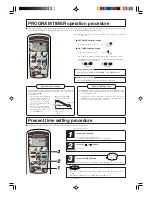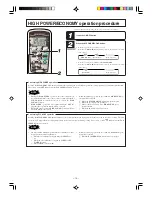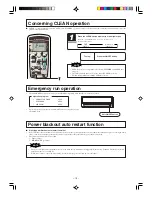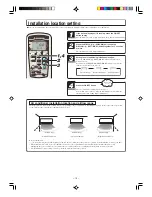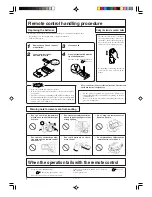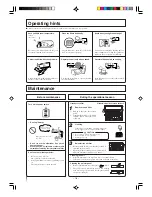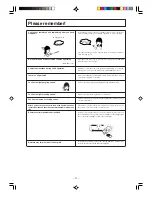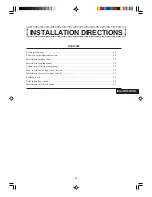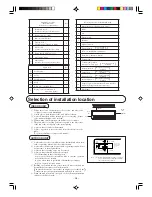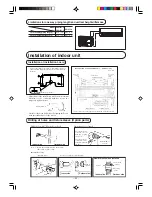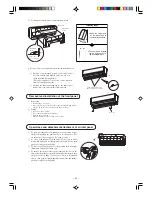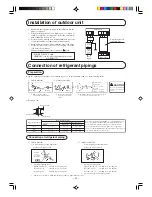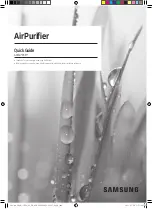
– 26 –
Safety precautions
•
When install the unit, be sure to check whether the selection of installation place, power supply specifications, usage limitation (piping
length, height differences between indoor and outdoor units, power supply voltage and etc.) and installation spaces.
•
We recommend you to read this “SAFETY PRECAUTIONS” carefully before the installation work in order to gain full advantage of the func-
tions of the unit and to avoid malfunction due to mishandling.
•
The precautions described below are divided into
WARNING
and
CAUTION
. The matters with possibilities leading to serious conse-
quences such as death or serious personal injury due to erroneous handling are listed in the
WARNING
and the matters with possibilities
leading to personal injury or damage of the unit due to erroneous handling including probability leading to serious consequences in some cases
are listed in
CAUTION
. These are very important precautions for safety. Be sure to observe all of them without fail.
•
Be sure to confirm no anomaly on the equipment by commissioning after completed installation and explain the operating methods as well as the
maintenance methods of this equipment to the user according to the owner’s manual.
•
Keep the installation manual together with owner’s manual at a place where any user can read at any time. Moreover if necessary, ask to hand
them to a new user.
•
For installing qualified personnel, take precautions in respect to themselves by using suitable protective clothing, groves, etc., and then perform
the installation works.
•
Please pay attention not to fall down the tools, etc. when installing the unit at the high position.
•
If unusual noise can be heard during operation, consult the dealer.
•
Symbols which appear frequently in the text have the following meaning:
Observe instructions
with great care
Strictly prohibited
Provide proper earthing
WARNING
•
Installation must be carried out by the qualified installer.
If you install the system by yourself, it may cause serious trouble such as
water leaks, electric shocks, fire and personal injury, as a result of a system
malfunction.
•
Install the system in full accordance with the instruction manual.
Incorrect installation may cause bursts, personal injury, water leaks, electric
shocks and fire.
•
Be sure to use only for household and residence.
If this appliance is installed in inferior environment such as machine shop
and etc., it can cause malfunction.
•
Use the original accessories and the specified components for installation.
If parts other than those prescribed by us are used, It may cause water leaks,
electric shocks, fire and personal injury.
•
Install the unit in a location with good support.
Unsuitable installation locations can cause the unit to fall and cause material
damage and personal injury.
•
Ensure the unit is stable when installed, so that it can withstand earth-
quakes and strong winds.
Unsuitable installation locations can cause the unit to fall and cause material
damage and personal injury.
•
Ventilate the working area well in the event of refrigerant leakage dur-
ing installation.
If the refrigerant comes into contact with naked flames, poisonous gas is
produced.
•
When installing in small rooms, take prevention measures not to exceed
the density limit of refrigerant in the event of leakage.
Consult the expert about prevention measures. If the density of refrigerant
exceeds the limit in the event of leakage, lack of oxygen can occur, which
can cause serious accidents.
•
After completed installation, check that no refrigerant leaks from the system.
If refrigerant leaks into the room and comes into contact with an oven or
other hot surface, poisonous gas is produced.
•
Use the prescribed pipes, flare nuts and tools for R410A.
Using existing parts (for R22 or R407C) can cause the unit failure and seri-
ous accidents due to burst of the refrigerant circuit.
•
Tighten the flare nut by torque wrench with specified method.
If the flare nut were tightened with excess torque, this may cause burst and
refrigerant leakage after a long period.
•
Do not open the operation valves for liquid line and gas line until com-
pleted refrigerant piping work, air tightness test and evacuation.
If the compressor is operated in state of opening operation valves before
completed connection of refrigerant piping work, air can be sucked into re-
frigerant circuit, which can cause bust or personal injury due to anomalously
high pressure in the refrigerant.
•
Do not put the drainage pipe directly into drainage channels where poi-
sonous gases such as sulphide gas can occur.
Poisonous gases will flow into the room through drainage pipe and seriously
affect the user’s health and safety.
•
Ensure that no air enters in the refrigerant circuit when the unit is in-
stalled and removed.
If air enters in the refrigerant circuit, the pressure in the refrigerant circuit
becomes too high, which can cause burst and personal injury.
•
Do not processing, splice the power cord, or share a socket with other
power plugs.
This may cause fire or electric shock due to defecting contact, defecting in-
sulation and over-current etc.
•
The electrical installation must be carried out by the qualified electri-
cian in accordance with “the norm for electrical work” and “national
wiring regulation”, and the system must be connected to the dedicated
circuit.
Power supply with insufficient capacity and incorrect function done by im-
proper work can cause electric shocks and fire.
•
Be sure to shut off the power before starting electrical work.
Failure to shut off the power can cause electric shocks, unit failure or incor-
rect function of equipment.
•
Be sure to use the cables conformed to safety standard and cable
ampacity for power distribution work.
Unconformable cables can cause electric leak, anomalous heat production or
fire.
•
This appliance must be connected to main power supply by means of a
circuit breaker or switch (fuse:16A) with a contact separation of at least
3mm.
•
When plugging this appliance, a plug conforming to the norm
IEC60884-1 must be used.
•
Use the prescribed cables for electrical connection, tighten the cables
securely in terminal block and relieve the cables correctly to prevent
overloading the terminal blocks.
Loose connections or cable mountings can cause anomalous heat production
or fire.
•
Arrange the wiring in the control box so that it cannot be pushed up
further into the box. Install the service panel correctly.
Incorrect installation may result in overheating and fire.
•
Be sure to fix up the service panels.
Incorrect fixing can cause electric shocks or fire due to intrusion of dust or
water.
•
Be sure to switch off the power supply in the event of installation, inspec-
tion or servicing.
If the power supply is not shut off, there is a risk of electric shocks, unit
failure or personal injury due to the unexpected start of fan.
•
Stop the compressor before disconnecting refrigerant pipes in case of
pump down operation.
If disconnecting refrigerant pipes in state of opening operation valves before
compressor stopping, air can be sucked, which can cause burst or personal
injury due to anomalously high pressure in the refrigerant circuit
•
Only use prescribed optional parts. The installation must be carried out
by the qualified installer.
If you install the system by yourself, it can cause serious trouble such as
water leaks, electric shocks, fire.
•
Do not bundling, winding or processing for the power cord. Or, do not
deforming the power plug due to tread it.
This may cause fire or heating.
•
Do not vent R410A into the atmosphere : R410A is a fluorinated green-
house gas, covered by the Kyoto Protocol with Global Warming Poten-
tial (GWP)=1975.
•
Do not run the unit with removed panels or protections.
Touching rotating equipments, hot surfaces or high voltage parts can cause
personal injury due to entrapment, burn or electric shocks.
•
Do not perform any change of protective device itself or its setup condition.
The forced operation by short-circuiting protective device of pressure switch
and temperature controller or the use of non specified component can cause
fire or burst.
•
Carry out the electrical work for ground lead with care.
Do not connect the ground lead to the gas line, water line, lightning conductor or telephone line’s ground lead. Incorrect grounding can cause unit faults such
as electric shocks due to short-circuiting.
Summary of Contents for SRK10YL-S
Page 25: ... 24 ...


